Architectural Sci-Fi
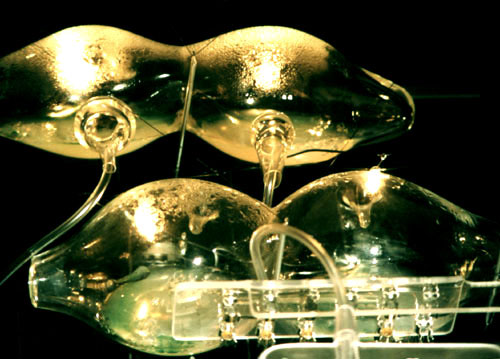 [Image: Steve Pike].
[Image: Steve Pike].I picked up a few books yesterday at Hennessey + Ingalls, including a collection of student work from Unit 20 of the increasingly exciting Bartlett School of Architecture in London. The book is edited by Marcos Cruz and Salvador Pérez Arroyo, and its projects date from 1999-2002.
It's also amazingly interesting.
I can't find any links to it online, however, so I'll just give you a random walk-through of the book's contents...
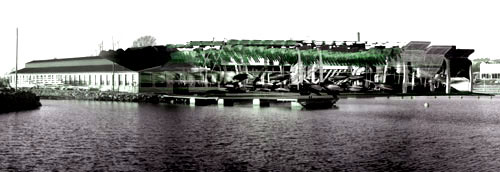
 [Image: James Foster].
[Image: James Foster].There's James Foster's "Inhabitable Growthscape," a "series of incubators" which he constructed from vacuum-formed perspex and electronic circuitry; the system's larger architectural applications are pictured above: it's part boatyard, part aeroponic farm for the cultivation of "disease free cloned plants."
There's then a ten-page spread by Kevin Chu illustrating the industrial use of "clustering robots." Chu describes a colony of "mining robots breeding on a lake in Helsinki," as well as a cluster of similar robots "forming a silicon mining factory in Tenerife." These are "small-scale insect-like robots which form a tactile and transformable surface," although "the overall form alters according to the relocation of individual entities." In other words, it's an Artificially Intelligent swarm of robots transforming the surface of the earth into a quarry...
In fact, if I can interject something here, the book is a little preoccupied with insect shapes and machinery – to the point of looking like a deleted scene from Minority Report 2 – so I will say that architectural studios should be wary of turning themselves into machine-development classes; but that's a minor complaint, and a larger discussion.
 [Image: Lisa Silver].
[Image: Lisa Silver].We then turn to RIBA Award-winner Lisa Silver, whose architecture consists of "alien objects... fused, subverted and juxtaposed to form a unified whole."
Specifically, Silver presents a space defined by "surfaces and meshes of varied transparency," made from roof suspension systems and ramps. The result is a bricolage of car chassis and old farm implements, assembled on the banks of the Mississippi River.
 [Image: Lisa Silver].
[Image: Lisa Silver].Tom Foster, then, proposes a "swarm of hyper crystallisation submersible robots" that will spend an entire winter underwater in the Gulf of Helsinki, "artificially enhancing the ice sheet from underneath." This – referred to as "ice periphery management" – is done in the service of an "ice suburb" that "will exist [out on the ice] for 5 months of each year." The ice sheet can be strengthened with "coolant filled reinforcement bars," and the ice suburb will generate its own energy "from high winter winds and sea/ice movements."
So you've got an entire sci-fi trilogy, economically compressed into a few renderings and photo captions.
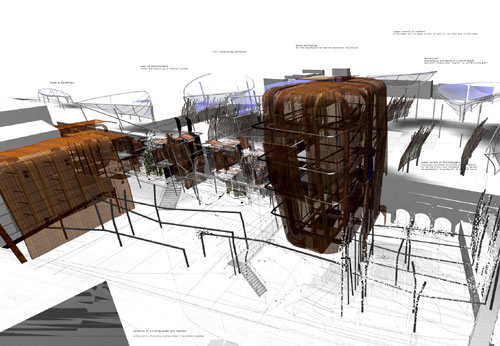 [Image: Annika Schollin].
[Image: Annika Schollin].Returning to land, Annika Schollin writes about urban decay, abandoned buildings, and the formation of "micro-jungles within the urban structure."
Concentrating specifically on London's Brick Lane, Schollin describes how the unmaintained city is soon "reeking of rot and humidity." Her project is a way of "[c]elebrating decay," she explains, "as the organic inhabitants of the site begin to take over, weaving through, ambivalently undermining and reinforcing the built structure." The actual architectural proposal appears to involve constructing a kind of permanent exoskeleton around the ruined markets of Brick Lane, complete with "water dispensing ducts" and a "hydro percolating roof."
So – almost literally to repeat myself – architectural design becomes more and more like science fiction.
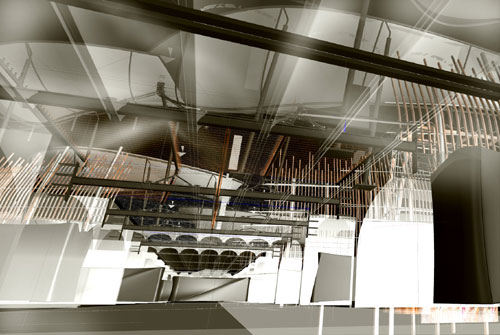 [Image: Annika Schollin].
[Image: Annika Schollin].Other projects have a distinctly biological theme – including open bacteriological collaboration with the microbiology lab at University College London. Steve Pike, for instance, outlines an "algaetecture" of blown glass and high transparency acrylic. Inspired by the industrial manufacture of car windshields, these glass structures look simultaneously deformed, alchemic, and bio-anatomical.
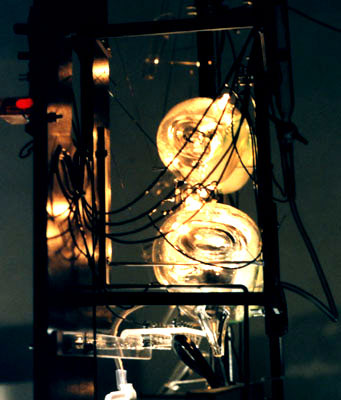
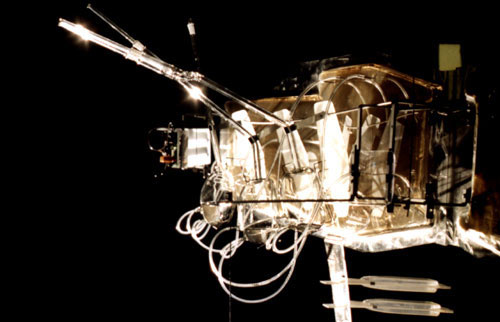 [Images: Steve Pike's "vitreous occupational chambers" and "monitor vessel support infrastructure"].
[Images: Steve Pike's "vitreous occupational chambers" and "monitor vessel support infrastructure"].Pike explains how he built glass Interaction Vessels, Monitor Vessels, and Transformer Vessels, studying so-called algaetectural "parallels to human occupation." He has an essay later in the book about contamination, the London Underground, and "non-sterile environments," in which he proposes a catchment mechanism for airborne particles (the illustrations of which look like a scene from Alphaville).
I could go on and on here. I just think the ideas are great (excuse the enthusiasm, if this isn't your thing).
For instance, there's a project by Mark Mueckenheim called "London Urban Farming." Mueckhenheim points out that the decline of farmland throughout the EU will necessitate "bring[ing] farming into the urban fabric." He thus proposes a food processing plant "with a fish hatchery attached to its façade."
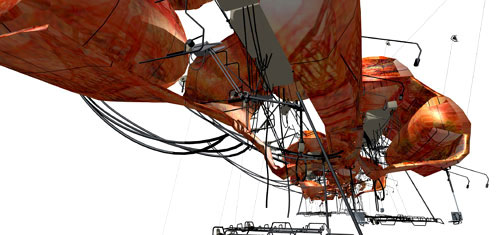 [Image: One of Mark Mueckenheim's urban farms; again, note the insectile nature of student work produced for this unit].
[Image: One of Mark Mueckenheim's urban farms; again, note the insectile nature of student work produced for this unit].The rest of the book confronts us with acoustic wind membranes; the city of Chicago as a kind of machine made out of retractable bridges; health clinics and sports research institutes; a hydroponic farm, by Stephen Clements, apparently modeled after the human nervous system; and even a Finnish fish farm, by Natalia Traverso Caruana, where "research labs and fish nets creat[e] a new luminous landscape" in the sea.
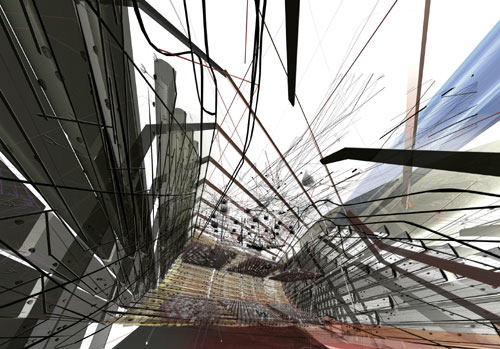
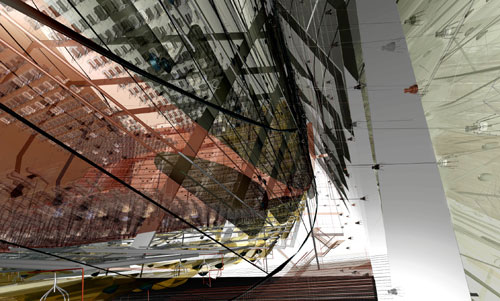 [Image: Natalia Traverso Caruana's cultural HQ for Texaco].
[Image: Natalia Traverso Caruana's cultural HQ for Texaco].Caruana's next project is a "cultural branch" for the headquarters of Texaco – it's magnificently colored and practically leaps off the page.
There are strange photographic labs, and elevators that appear to analyze their passengers' DNA. There's even a plastic surgery lounge, or "Body Transformation" complex, proposed for Heathrow Airport, by Jia Lu (something tells me this will actually be constructed). Andy Shaw jumps in at the very end of the book with some robotic machine-space studies for "technical appliances based on the work of Eduardo Paolozzi."
Etc. etc. etc.
In other words, I like the book. Unfortunately, it doesn't appear to exist anywhere online, so you'll just have to take my word for it – or you can visit the Bartlett's various Unit 20 homepages.
Finally, my larger point in citing and describing so many of these projects is to demonstrate, in perhaps exhaustive detail, that some of today's most imaginative artistic, technological, and even literary work is being produced in architectural studios. Whether you like their projects or not, in other words, architecture students are out-thinking, out-structuring, and out-performing novelists, hands down.
It is now architecture that lets us rethink the world anew.





Comments are moderated.
If it's not spam, it will appear here shortly!
but where/what is the ideal (or most appropriate--or just feasible, really) forum/medium in which to 'voice' these ideas, which straddle the line between architecture and fiction? it's not to be found in your typical architectural competition, but at the same time it's not 'art'. is there really any other way to do it than to publish a book that will only be available in posh socal arch. bookstores?
HM ok attempt no 2 to get this up.
I don't think architects are out doing science fiction, I just feel the expecctations for science fiction have changed. All great science fiction is drawing a line from the present to an imagined point in the future. (With a few curves thrown in to be sure.) As far a buildings and designs I doubt at this point people expect or even want thier buildings to look like that any more.
As an aside calling them designs is appropriate because half those picture are just that, no real fucntion is apperent just pure design.
As far as fernandos question of an ideal way to present these ideas, I think the blame falls on the students themselves for being too narrow in application.
what ever happened to the good old fashioned artist/designer and futurist. I can't even imagine what my childhood would be like without Syd Mead
this post used to end up with the phrase 'literaure has failed' being tossed to us. although it looks like you have had second thoughts and removed that line (and in doing so broken blogging conventions against 'altering history' to make yourself seem always correct), could you explain the shortcomings of literature (aside from the fact that it usually has no pictures)?
how can you read mr palomar, against the grain, or projet pour une révolution à new-york and finish the book thinking about 'the world' in the same way?
is the job of the novelist necessarily to envision zany hybrid environments for us, anyway? should they worry about failing in that?
does any of the stuff in those projects actually work (elevators that scan your DNA - i hope not)? because if these students get away with just proposing fantasies with no mechanical conclusions, i suggest you read some some jules verne, and get back to us in 100 years.
++
alternately, if you have removed that line because you have realized that literature has succeeded, after all - how so?
Hey Thomas - Well, I think going back to edit a blog post so that it doesn't end with pathological hyperbole or deliberate over-statement is well within my rights - nor does it violate any "blogging convention" I'm aware of. But thanks for anonymously trying to enforce something that other people haven't agreed to; it's an admirable character trait, and seems no wonder you'd then sneak in a reference to Big Brother. I can edit anything I want on BLDGBLOG without being accused of trying to alter history or to make myself seem "always correct," which is an absurd accusation to make of someone who simply wants to edit their own writing for clarity.
In fact, the entire discussion at the end of this post was added later, only after the post had been online for several hours. In other words, I went back and edited the project descriptions, I editorialized a bit more in some places, I fixed some captions, and I edited the actual writing; but then I got up this morning and erased the phrase "literature has failed" - which was only added last night. Literally every single post has a pre-draft, so it seems completely arbitrary whether or not I edit something after I've hit "publish" or after I've hit "preview."
And to judge architectural proposals simply by whether or not they can be physically constructed is like rejecting a novel because it describes fictional events. Alice In Wonderland should not be rejected because of how unlikely it is that a small British girl can fall down a magical rabbit hole - so who cares whether or not a swarm of underwater robots will ever mechanically repair ice floes in the Gulf of Helsinki...? It's beautiful as a concept - as a fictional and literary concept - and to worry about whether it will "actually work" seems totally beside the point. These students are not "get[ting] away" with something, despite your comments - as if "just proposing fantasies" is something to apologize for in the first place.
And as far as Jules Verne goes, I agree with you; but it seems rather telling that Verne was writing more than a century ago - and, thus, I feel like he proves my larger point. If contemporary literature would rather dwell on the ironic hilarity of NYC shopping sprees, or on politically irrelevant rural family sagas, with absolutely nothing to offer intellectually, imaginatively, or even emotionally, then it shouldn't surprise anyone that novels - in the United States - are increasingly difficult to sell to the general public. It also shouldn't surprise anyone that the big ideas - whatever those even are - have migrated elsewhere: to science, nonfiction, architecture, etc. The above post is simply an attempt to point out that a relatively small group of architecture students at a school in England have out-thought most of the American literary establishment - and, frankly, I don't care if that statement is "correct" or not; it's just the way I feel about contemporary fiction. Changing the way I phrase the above sentiment doesn't turn me into Big Brother, nor does it warrant the accusation.
I'm also not afraid to use my real name when offering these opinions.
We get what we deserve, I suppose...
Happy holidays, Tim. You staying in LA?
In regard to BLDGBLOG's query, see "Copyfraud" in a recent volume to the NYU Law Review. Abstract:
Copyfraud is everywhere. False copyright notices appear on modern reprints of Shakespeare's plays, Beethoven's piano scores, greeting card versions of Monet's Water Lilies, and even the U.S. Constitution. Archives claim blanket copyright in everything in their collections. Vendors of microfilmed versions of historical newspapers assert copyright ownership. These false copyright claims, which are often accompanied by threatened litigation for reproducing a work without the owner's permission, result in users seeking licenses and paying fees to reproduce works that are free for everyone to use.
Copyright law itself creates strong incentives for copyfraud. The Copyright Act provides for no civil penalty for falsely claiming ownership of public domain materials. There is also no remedy under the Act for individuals who wrongly refrain from legal copying or who make payment for permission to copy something they are in fact entitled to use for free. While falsely claiming copyright is technically a criminal offense under the Act, prosecutions are extremely rare. These circumstances have produced fraud on an untold scale, with millions of works in the public domain deemed copyrighted, and countless dollars paid out every year in licensing fees to make copies that could be made for free. Copyfraud stifles valid forms of reproduction and undermines free speech.
Congress should amend the Copyright Act to allow private parties to bring civil causes of action for false copyright claims. Courts should extend the availability of the copyright misuse defense to prevent copyright owners from enforcing an otherwise valid copyright if they have engaged in past copyfraud. In addition, Congress should further protect the public domain by creating a national registry listing public domain works and a symbol to designate those works. Failing a congressional response, there may exist remedies under state law and through the efforts of private parties to achieve these ends.
So, though rare, it appears someone could be prosecuted (by the govt) for falsely claiming copyright protection for material in the public domain, although a private citizen currently has no remedy.
Also, you raise an interesting point about the merits/demerits of posting anonymously. I generally post anonymously because of worries about running into static at work, at customs, or perhaps ending up on some list because of the topics I post about (which, though usually inane and trite, are sometimes political). I imagine many bloggers do the same, for similar reasons. Not that the protections of blogspot will spare us if push comes to shove.
Perhaps we should all be brave enough to post in our own names. But it may depend on what one is blogging about. If one is blogging about art, that is one thing, and it seems unlikely that one would land on some crazy database compiled by DARPA for one's scathing criticism; if one is criticizing AEI, the DoD, etc., it seems more possible. This may, of course, be paranoia, but it's hard to know what is too paranoid these days, right? (Or am I being paranoid?)
! unbelievable content! really like this place. carry on with the nice job and merry christmas!
Cheers Randolph, I was also looking for that one (it's on Amazon UK but the publication by Universitat Politecnica De Valencia had me fooled). And thanks Geoff, for yet more cool ideas and yet another addition to my wishlist. Festivities, all!
Hey Randolph - Thanks for the book link!
Post a Comment